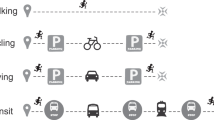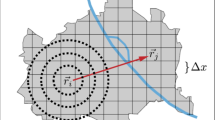Abstract
Background
Traffic-related air pollutants lead to increased risks of many diseases. Understanding travel patterns and influencing factors are important for mitigating traffic exposures. However, there is a lack of national large-scale research.
Objective
This study aimed to evaluate the daily travel patterns of Chinese adults and provide basic data for traffic exposure and health risk research.
Methods
We conducted the first nation-wide survey of travel patterns of adults (aged 18 and above) in China during 2011–2012. We conducted a cross-sectional study based on a nationally representative sample of 91, 121 adults from 31 provinces in China. We characterized typical travel patterns by cluster analysis and identified the associated factors of each pattern using multiple logistic regression and generalized linear regression models.
Results
We found 115 typical daily travel patterns of Chinese adults and the top 11 accounted for 94% of the population. The interaction of age, urban and rural areas, income levels, gender, educational levels, city population and temperature affect people’s choice of travel patterns. The average travel time of Chinese adults is 45 ± 40 min/day, with the longest travel time by the combination of walking and car (70 min/day). Gender has the largest effect on travel time (B = −8.94, 95% CI: −8.95, −8.93), followed by city GDP (B = −4.23, 95% CI: −4.23, −4.22), urban and rural areas (B = −3.62, 95% CI: −3.63, −3.61), age (B = −2.21, 95% CI: −2.21, −2.2), educational levels (B = −1.53, 95% CI: −1.53, −1.52), city area (B = −1.4, 95% CI: −1.4, −1.39) and temperature (B = 1.21, 95% CI: 1.2, 1.21).
Significance
This study was the first nation-wide study on traffic activity patterns in China, which provides basic data for traffic exposure and health risk research and provides the basis for the state to formulate transportation-related policies.
This is a preview of subscription content, access via your institution
Access options
Subscribe to this journal
Receive 6 print issues and online access
$259.00 per year
only $43.17 per issue
Buy this article
- Purchase on Springer Link
- Instant access to full article PDF
Prices may be subject to local taxes which are calculated during checkout



Similar content being viewed by others
Data availability
The data that support the findings of this study are available from the corresponding author, (XD), upon reasonable request.
References
Gan WQ, Davies HW, Koehoorn M, Brauer M. Association of long-term exposure to community noise and traffic-related air pollution with coronary heart disease mortality. Am J Epidemiol. 2012;175:898–906. https://doi.org/10.1093/aje/kwr424.
Grigoratos T, Martini G. Brake wear particle emissions: a review. Environ Sci Pollut Res. 2014;22:2491–504. https://doi.org/10.1007/s11356-014-3696-8.
Liang D, Golan R, Moutinho JL, Chang HH, Greenwald R, Sarnat SE, et al. Errors associated with the use of roadside monitoring in the estimation of acute traffic pollutant-related health effects. Environ Res. 2018;165:210–9. https://doi.org/10.1016/j.envres.2018.04.013.
Sunyer J, Esnaola M, Alvarez-Pedrerol M, Forns J, Rivas I, Lopez-Vicente M, et al. Association between traffic-related air pollution in schools and cognitive development in primary school children: a prospective cohort study. PLoS Med. 2015;12:e1001792. https://doi.org/10.1371/journal.pmed.1001792.
Weuve J, Kaufman JD, Szpiro AA, Curl C, Puett RC, Beck T, et al. Exposure to traffic-related air pollution in relation to progression in physical disability among older adults. Environ Health Perspect. 2016;124:1000–8. https://doi.org/10.1289/ehp.1510089.
Huls A, Abramson MJ, Sugiri D, Fuks K, Kramer U, Krutmann J, et al. Nonatopic eczema in elderly women: Effect of air pollution and genes. J Allergy Clin Immunol. 2019;143:378–85.e9. https://doi.org/10.1016/j.jaci.2018.09.031.
Blount RJ, Pascopella L, Catanzaro DG, Barry PM, English PB, Segal MR, et al. Traffic-related air pollution and all-cause mortality during tuberculosis treatment in California. Environ Health Perspect. 2017;125. https://doi.org/10.1289/ehp1699.
Bowatte G, Lodge CJ, Knibbs LD, Erbas B, Perret JL, Jalaludin B, et al. Traffic related air pollution and development and persistence of asthma and low lung function. Environ Int. 2018;113:170–6. https://doi.org/10.1016/j.envint.2018.01.028.
Fuks KB, Weinmayr G, Basagaña X, Gruzieva O, Hampel R, Oftedal B, et al. Long-term exposure to ambient air pollution and traffic noise and incident hypertension in seven cohorts of the European study of cohorts for air pollution effects (ESCAPE). Eur Heart J. 2016. https://doi.org/10.1093/eurheartj/ehw413.
Fuks KB, Weinmayr G, Foraster M, Dratva J, Hampel R, Houthuijs D, et al. Arterial blood pressure and long-term exposure to traffic-related air pollution: an analysis in the European Study of Cohorts for Air Pollution Effects (ESCAPE). Environ Health Perspect. 2014;122:896–905. https://doi.org/10.1289/ehp.1307725.
Alexeeff SE, Coull BA, Gryparis A, Suh H, Sparrow D, Vokonas PS, et al. Medium-term exposure to traffic-related air pollution and markers of inflammation and endothelial function. Environ Health Perspect. 2011;119:481–6. https://doi.org/10.1289/ehp.1002560.
Chen Y, Ebenstein A, Greenstone M, Li H. Evidence on the impact of sustained exposure to air pollution on life expectancy from China’s Huai River policy. Proc Natl Acad Sci USA. 2013;110:12936–41. https://doi.org/10.1073/pnas.1300018110.
Lubin JH, Moore LE, Fraumeni JF, Cantor KP. Respiratory cancer and inhaled inorganic arsenic in copper smelters workers: a linear relationship with cumulative exposure that increases with concentration. Environ Health Perspect. 2008;116:1661–5. https://doi.org/10.1289/ehp.11515.
Duan XL. Exposure Factors Handbook of Chinese Population. Ministry of Ecology and Environment of the People’s Republic of China, Beijing; 2013.
Zhang K, Batterman SA. Time allocation shifts and pollutant exposure due to traffic congestion: an analysis using the national human activity pattern survey. Sci Total Environ. 2009;407:5493–500. https://doi.org/10.1016/j.scitotenv.2009.07.008.
Zhang K, Batterman SA. Air pollution and health risks due to traffic and congestion. Sci Total Environ. 2013;450-1:307–16. https://doi.org/10.1016/j.scitotenv.2013.01.074.
Klepeis NE, Nelson WC, Ott WR, Robinson JP, Tsang AM, Switzer P, et al. The National Human Activity Pattern Survey (NHAPS): a resource for assessing exposure to environmental pollutants. J Exposure Anal Environ Epidemiol. 2001;11:231–52. https://doi.org/10.1038/sj.jea.7500165.
McCurdy T, Glen G, Smith L, Lakkadi Y. The National Exposure Research Laboratory’s consolidated human activity database. J Exposure Anal Environ Epidemiol. 2000;10:566–78. https://doi.org/10.1038/sj.jea.7500114.
AQEG. Particulate matter in the United Kingdom. Second Report (Draft) from the Air Quality Expert Group (AQEG). UK, 2004.
Suh H. Particulate matter. In: Nieuwenhuijsen MJ, editor. Exposure assessment in occupational and environmental epidemiology. Oxford: Oxford University Press; 2003.
Bhat CR, Sardesai R. The impact of stop-making and travel time reliability on commute mode choice. Transportation Res Part B Methodol. 2006;40:709–30. https://doi.org/10.1016/j.trb.2005.09.008.
Jang TY. Causal relationship among travel mode, activity, and travel patterns. J Transport Eng ASCE. 2003;129:16–22. https://doi.org/10.1061/(asce)0733-947x(2003)129:1(16).
Patil GR, Basu R, Rashidi TH. Mode choice modeling using adaptive data collection for different trip purposes in Mumbai metropolitan region. Transport Dev Econ. 2020;6:9. https://doi.org/10.1007/s40890-020-0099-z.
Asensio J. Transport mode choice by commuters to Barcelona’s CBD. Urban Stud. 2016;39:1881–95. https://doi.org/10.1080/0042098022000003000.
Guo J, Luo MJ, Cui SS, Chen N. Research on urban residents’ travel mode choice based on structural equation model. Highways and Automotive Applications. CNKI:SUN:ZNQY.0.2020-02-009. 2020:30–35.
EPA. U.S. Exposure Factors Handbook. Washington, DC: USEPA; 2011.
Gong WT, Feng GY, Yuan F, Ding CC, Zhang Y, Liu AL. Analysis on the changing trends of transportation modes and time among Chinese non-agricultural professional population in 2002 and 2010-2. Acta Nutrimenta Sin. 2017;39:327–31. CNKI:SUN:YYXX.0.2017-04-007.
Li TT, Yan M, Liu JF, Zhang GS, Luo M, Huo MQ, et al. Air quality assessment in public transportation vehicles in Beijing. 2008:514–6. https://doi.org/10.16241/j.cnki.1001-5914.2008.06.024.
Wang BB, Duan XL, Jiang QJ, Huang N, Qian Y, Wang ZS, et al. Inhalation exposure factors of residents in a typical region in Northern China. Res Environ Sci. 2010;23:1421–7. CNKI: SUN: HJKX.0.2010-11-015.
Santos ANM, Nakamoto HY, Gray D, Liss S. Summary of Travel Trends: 2009. National Household Travel Survey; U.S., 2011.
Liu MJ. Traffic survey in Japan. Traffic and transportation. 2000:32–34. CNKI:SUN:YSJT.0.2000-02-017.
Jang JY-JS, Kim SY, Kim SJ, Cheong HK. Korea Exposure Factors Handbook. 2007.
Australia. (2012) Australia Exposure Factor Guide. Australian Bureau of Statistics.
Ma GS, Kong LZ. Survey report on nutrition and health status of Chinese residents: behavior and lifestyle in 2002. Beijing: People’s medical publishing house; 2002.
Conrad A, Seiwert M, Hunken A, Quarcoo D, Schlaud M, Groneberg D. The German Environmental Survey for Children (GerES IV): Reference values and distributions for time-location patterns of German children. Int J Hyg Environ Health. 2013;216:25–34. https://doi.org/10.1016/j.ijheh.2012.02.004.
Zou B, Li S, Lin Y, Wang B, Cao S, Zhao X, et al. Efforts in reducing air pollution exposure risk in China: State versus individuals. Environ Int. 2020;137:105504. https://doi.org/10.1016/j.envint.2020.105504.
Shen Q, Chen P, Pan H. Factors affecting car ownership and mode choice in rail transit-supported suburbs of a large Chinese city. Transportation Res Part A Policy Pract. 2016;94:31–44. https://doi.org/10.1016/j.tra.2016.08.027.
Luan X, Deng W, Cheng L, Chen XY. Mixed Logit model for understanding travel mode choice behavior of megalopolitan residents. Journal of Jilin University (Engineering and Technology Edition). 2018. https://doi.org/10.13229/j.cnki.jdxbgxb20170561.
Ling XJ, Yang T, Shi Q. Discussion on public transit mode share. Urban Transport of China. 2014:26–33. https://doi.org/10.13813/j.cn11-5141/u.2014.0505.
Christian AK, Friedrichsmeier T. A multi-level approach to travelmode choice—how person characteristics and situation specific aspects determine car use in a student sample. 2011;14:0–277. https://doi.org/10.1016/j.trf.2011.01.006.
Jiang Y, Zou Z. Impact of travel time consumption on Tianjin public transport travel and Its Improvement Countermeasures, Annual meeting and Symposium of China Urban Transport Planning Academic Committee. 2005. https://d.wanfangdata.com.cn/conference/6130081.
USA. Exposure Factors Handbook: 2011 Edition. 2011.
Lilah M, Besser M, Andrew L, Dannenberg MD,MPH. Walking to public transit: steps to help meet physical activity recommendations. Am J Preven Med. 2005;29:273–80. https://doi.org/10.1016/j.amepre.2005.06.010.
Collia DV, Sharp J, Giesbrecht L. The 2001 National Household Travel Survey: a look into the travel patterns of older Americans. J Saf Res. 2003;34:461–70. https://doi.org/10.1016/j.jsr.2003.10.001.
Li ZY, Li C, Yin ZF. Development of transportation carbon emission in Germany and Japan and Its Enlightenment to China. Highways and Automotive Applications. 2014:35–8. https://doi.org/10.3969/j.issn.1671-2668.2014.01.011.
Pucher J, Renne JL. Rural mobility and mode choice: Evidence from the 2001 National Household Travel Survey. Transportation. 2005;32:165–86. https://doi.org/10.1007/s11116-004-5508-3.
Wang CM, Shi YP, Wei JR, Ma Y, Zhang Y. Characteristics of time-activity patterns of adult residents in Beijing in winter. Capital J Public Health. CNKI:SUN:SDGW.0.2017;05;19–23.
Wang CM, Zhao JH, Shi YP, Zhang Y, Su P, Li T. Characteristics of time-activity patterns of residents living in Beijing in summer. J Environ Health. 2019. https://doi.org/10.16241/j.cnki.1001-5914.2019.08.015.
Meng B, Zheng LM, Yu HL. Commuting time change and its influencing factors in Beijing. Prog Geog. 2011;30:1218–24. https://doi.org/10.11820/dlkxjz.2011.10.003.
Lu XM, Gu XT. The fifth travel survey of residents in Shanghai and characteristics analysis. Urban Transp China. 2011;000:1–7. https://doi.org/10.3969/j.issn.1672-5328.2011.05.001.
Besser LM, Dannenberg AL. Walking to public transit: steps to help meet physical activity recommendations. Am J Prev Med. 2005;29:273–80. https://doi.org/10.1016/j.amepre.2005.06.010.
Jan P, Stewart B. Moving towards sustainability? Mobility styles, attitudes and individual travel behaviour. J Trans Geog. 2011;19:0–1600. https://doi.org/10.1016/j.jtrangeo.2011.06.011.
Acknowledgements
We thank all the study participants and field investigators.
Funding
This work was supported by the National Science Foundation [grant numbers 41977374].
Author information
Authors and Affiliations
Contributions
NJ: Methodology, writing—review and editing, writing—original draft, visualization. LQ: Formal analysis, writing—review and editing. BW: Methodology, investigation, data curation. SC: Writing—review and editing. LW: Methodology, investigation, data curation, writing—review and editing. BZ: Resources, data curation. KZ: Writing—review and editing. NQ: Writing—review and editing. XD: Conceptualization, methodology, investigation, data curation, writing—review and editing, supervision, project administration, funding acquisition.
Corresponding author
Ethics declarations
Competing interests
The authors declare no competing interests.
Additional information
Publisher’s note Springer Nature remains neutral with regard to jurisdictional claims in published maps and institutional affiliations.
Supplementary information
Rights and permissions
Springer Nature or its licensor holds exclusive rights to this article under a publishing agreement with the author(s) or other rightsholder(s); author self-archiving of the accepted manuscript version of this article is solely governed by the terms of such publishing agreement and applicable law.
About this article
Cite this article
Jiang, N., Qi, L., Wang, B. et al. Traffic related activity pattern of Chinese adults: a nation-wide population based survey. J Expo Sci Environ Epidemiol 33, 482–489 (2023). https://doi.org/10.1038/s41370-022-00469-y
Received:
Revised:
Accepted:
Published:
Issue Date:
DOI: https://doi.org/10.1038/s41370-022-00469-y



